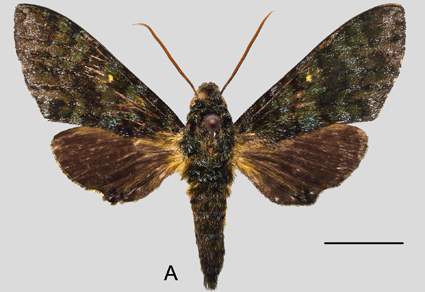Abstract
The two species currently included in the genus Pseudodolbina Rothschild, 1894, Pseudodolbina fo (Walker, 1856) and Pseudodolbina aequalis Rothschild & Jordan, 1903, were studied and a new species, Pseudodolbina yunnana sp. nov., was described from Yunnan, China. The diagnostic features and a distribution map of three species are provided, with a phylogenetic analysis based on DNA barcodes.
References
- Bertheau, C., Schuler, H., Krumböck, S., Arthofer, W. & Stauffer, C. (2011) Hit or miss in phylogenetic analyses: the case of the cryptic NUMTs. Molecular Ecology Resources, 11, 1056–1059. https://doi.org/10.1111/j.1755-0998.2011.03050.x
- Folmer, O., Black, M.B., Hoch, W., Lutz, R.A. & Vrijehock, R.C. (1994) DNA primers for amplification of mitochondrial cytochrome c oxidase subunit I from diverse metazoan invertebrates. Molecular Marine Biology and Biotechnology, 3, 294–299.
- Hall, T.A. (1999) BioEdit: a user-friendly biological sequence alignment editor and analysis program for Windows 95/98/NT. Nuclear Acids Symposium Series, 41, 95–98.
- Jiang, Z.H. & Huang, C.L. (Eds.) (2023) Hawkmoths of China. Haixia Art and Literature Publishing House, Fuzhou, 213 pp.
- Jordan, K. (1926) On some Old World Sphingidae. Novitates Zoologicae, 33, 379–384. https://doi.org/10.5962/bhl.part.21149
- Kimura, M. (1980) A simple method for estimating evolutionary rates of base substitutions through comparative studies of nucleotide sequences. Journal of Molecular Evolution, 16, 111–120. https://doi.org/10.1007/BF01731581
- Kitching, I.J. & Cadiou, J.-M. (2000) Hawkmoths of the world. The Natural History Museum, London & Cornell University Press, Ithaca, New York, 160 pp.
- Kumar, S., Stecher, G., Li, M., Knyaz, C. & Tamura, K. (2018) MEGA X: Molecular Evolutionary Genetics Analysis across computing platforms. Molecular Biology and Evolution, 35, 1547–1549. https://doi.org/10.1093/molbev/msy096
- Rothschild, L.W. (1894) Notes on Sphingidae, with descriptions of new species. Novitates Zoologicae, 1 (1), 91. https://doi.org/10.5962/bhl.part.24563
- Rothschild, L.W. & Jordan, K. (1903) A revision of the lepidopterous family Sphingidae. Novitates Zoologicae, 9 (Supplement), 827. https://doi.org/10.5962/bhl.title.5651
- Saitou, N. & Nei, M. (1987) The neighbor-joining method: a new method for reconstructing phylogenetic trees. Molecular Biology and Evolution, 4, 406–425. https://doi.org/10.1093/oxfordjournals.molbev.a040454
- Song, H., Buhay, J.E., Whiting, M.F. & Crandall, K.A. (2008) Many species in one: DNA barcoding overestimates the number of species when nuclear mitochondrial pseudogenes are coamplified. PNAS, 105, 13486–13491. https://doi.org/10.1073/pnas.0803076105
- Thompson, J.D., Higgins, D.G. & Gibson, T.J. (1994) CLUSTAL W: improving the sensitivity of progressive multiple sequence alignment through sequence weighting, position-specific gap penalties and weight matrix choice. Nuclear Acids Research, 22, 4673–4680. https://doi.org/10.1093/nar/22.22.4673
- Walker, F. (1856) List of the Specimens of Lepidopterous Insects in the Collection of the British Museum. Part VIII. Trustees of the British Museum, London, 195 pp.
- Xu, Z.B., Melichar, T., He, J.B., Zhang, C., Zhang, X.Y., Feng, D. & Hu, S.J. (2022) A new species of Rhodambulyx Mell, 1939 (Lepidoptera: Sphingidae) from Southwest Chongqing, China. Zootaxa, 5105, 48–62. https://doi.org/10.11646/zootaxa.5105.1.2
- Xu, Z.B., He, J.B., Yang, N., Kitching, I.J. & Hu, S.J. (2023) Review of the Narrow-Banded Hawkmoth, Neogurelca montana (Rothschild & Jordan, 1915) (Lepidoptera: Sphingidae) in China, with Morphological and Phylogenetic Analysis. Insects, 14, 818. https://doi.org/10.3390/insects14100818


